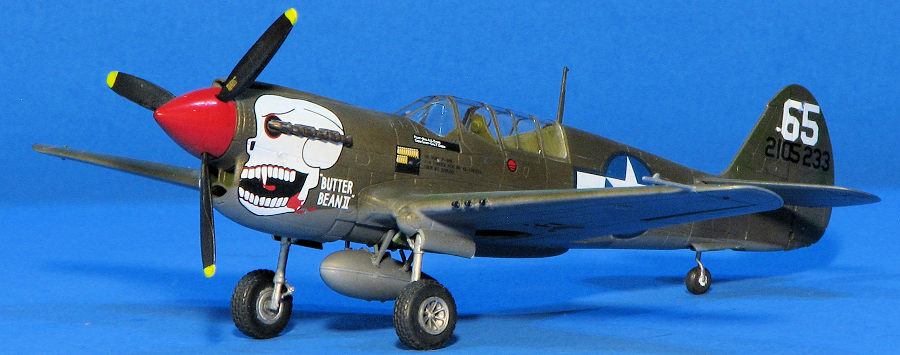
| KIT #: | SH 72374 |
| PRICE: | $25.00 |
| DECALS: | Four options |
| REVIEWER: | Scott Van Aken |
| NOTES: | 2017 boxing |

| HISTORY |
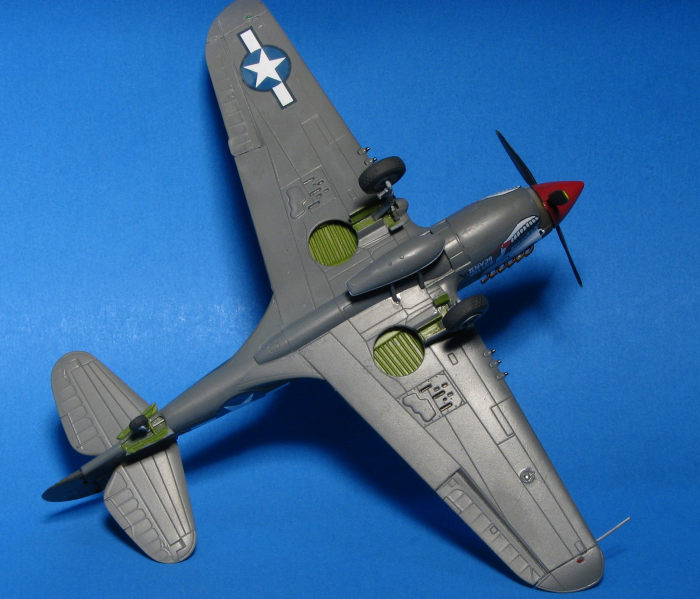 The P-40 was a follow-on of
the radial engine P-36, itself a modern, all metal fighter with retractable
landing gear. The in-line Allison V-1710 engine was installed to bring its
performance up to specs with fighter aircraft in Europe. For the most part,
Curtiss was successful in that regard. The P-40E was the first of the type that
was truly combat ready, though earlier P-40B/C variants did see combat in Burma,
China, and North Africa with the AVG, and the RAF.
The P-40 was a follow-on of
the radial engine P-36, itself a modern, all metal fighter with retractable
landing gear. The in-line Allison V-1710 engine was installed to bring its
performance up to specs with fighter aircraft in Europe. For the most part,
Curtiss was successful in that regard. The P-40E was the first of the type that
was truly combat ready, though earlier P-40B/C variants did see combat in Burma,
China, and North Africa with the AVG, and the RAF.
The addition of the armor and self sealing fuel tanks along with the addition of two more guns in the wings required a more powerful engine. However all this also slightly degraded the aircraft's performance. Probably the biggest failing of the aircraft was its inability to operate much above 15,000 feet as the lack of a high altitude supercharger or turbocharger meant that engine power dropped off quite a bit the higher it went. This was not an issue in the Pacific or North Africa as most combat was at levels below that and the P-40 was able to give a good showing against most of its adversaries.
Though the P-40 was further developed, it was more and more used as a fighter bomber in the ground attack role, letting more modern types handle the air to air bomber escort role in Europe and in the Mediterranean. In the CBI and the Pacific, the P-40 stayed in front line service longer than anywhere else. The rugged airframe and ease of maintenance made it perfect for areas with minimal services. The nearly complete lack of air opposition also meant that this now obsolescent aircraft was still a potent force. The P-40 N was the last full production version and was built in larger numbers than all previous variants.
| THE KIT |
After building the P-40E a few years back, I was impressed enough to grab the P-40N kit, even though I already have this versin in Academy and Hasegawa boxings. Actually, you cannot have too many P-40s, in my opinion and I have a shelf full of completed Warhawks to prove it!
 Looking at the sprues you
can see that many variants are in the works and indeed, Special Hobby has
released most of them already; some with p.e. in them. The detail
level is quite good, though perhaps a bit overdone for some tastes. I liken the
panel lines and parts detailing to be closer to Academy than the petite panel
lines of Hasegawa's forty year old kits.
Looking at the sprues you
can see that many variants are in the works and indeed, Special Hobby has
released most of them already; some with p.e. in them. The detail
level is quite good, though perhaps a bit overdone for some tastes. I liken the
panel lines and parts detailing to be closer to Academy than the petite panel
lines of Hasegawa's forty year old kits.
However, the cockpit details are vastly superior to Hasegawa's offerings. I like that there are belt decals. Decals are also provided for the main instrument panel. An interesting feature is that the cockpit floor is part of the upper wing piece. The kit gives us separate wheel well walls to trap in between the upper and lower wing halves. Ailerons are molded into the upper wing piece to provide a sharp trailing edge.
The kit offers exhaust as a single piece per side rather than the three pairs for each side as with the P-40E. Rudder is separate. The tailplanes are single piece and slot into the tail sections. You are provided open or closed cowl flap options, a nice choice. One can pose the canopy open or closed as two different canopies are provided for this. For things under the fuselage, you get one of two drop tank options, or a bomb. I found the supports for this to be fiddly to the max as the attachment points are not well defined.
The full color instructions are very well done and offer Gunze paint options. All of the options are in olive drab over neutral grey with medium green splotches on the leading and trailing edges of the flight surfaces. The box art plane is with the 49th FG/7th FS in New Guinea during 1944. It has the white wing leading edges and white tail that were standard for this theater. Note that on the horizontal stabls, the white is only on the underside and not on the elevators. Nose is blue with a white stripe. Next is a 80th FG/89th FS plane based at Assam, India in 1944 with the unit's fearsome skull motif and a red spinner. Then there are two Dutch planes both similarly done, though one has a white surround to the insignia. Decals are very nicely done by Cartograf so you know it is a good one.
| CONSTRUCTION |
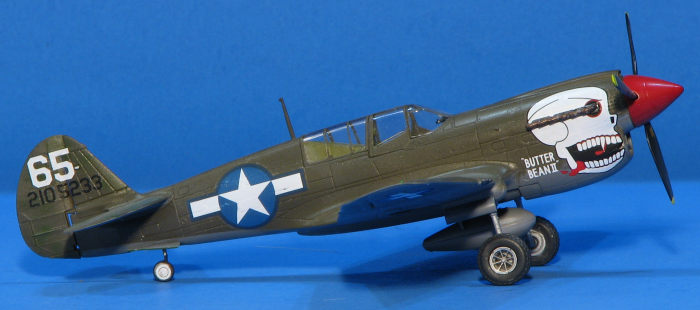 I was building this one in
conjunction with a P-40 E so things went concurrently until it got to the
interior. On this kit, I decided to use an aftermarket resin set from Special
Hobby, allegedly designed just for this kit. This is set Q72 301. This set is
basically sidewalls and a new control stick. I first painted them along with
other interior areas using Mission Models US interior green. While I was at it,
I painted all the gear wells and inner gear doors with Testors chromate green.
I was building this one in
conjunction with a P-40 E so things went concurrently until it got to the
interior. On this kit, I decided to use an aftermarket resin set from Special
Hobby, allegedly designed just for this kit. This is set Q72 301. This set is
basically sidewalls and a new control stick. I first painted them along with
other interior areas using Mission Models US interior green. While I was at it,
I painted all the gear wells and inner gear doors with Testors chromate green.
The sidewalls were then attached and all looked good to go. The nose radiator piece was painted as was the instrument panel. These were then installed and the fuselage halves glued together. The instrument panel proved to be a real pain to get in there just right. Then the wing with its separate gear wells was glued together. I really like that the upper wing is a single piece and also includes the cockpit floor. At this point I should mention that generally, the fit is fairly good, though some filler will be needed as you'll see in a bit.
Tailplanes and rudder were then glued in place. When it came to attaching the wing, it would not fit at all. The issue there, I believe, is that the sidewall pieces jut too far down. In the end, I used filler to deal with the step between the root and upper wing. It is something I'll remember for the next time I build one of these.
With the wing in place, I masked the canopy using Special Mask M72016, which fit perfectly. Then the canopy was attached using Cementine clear glue.
| COLORS & MARKINGS |
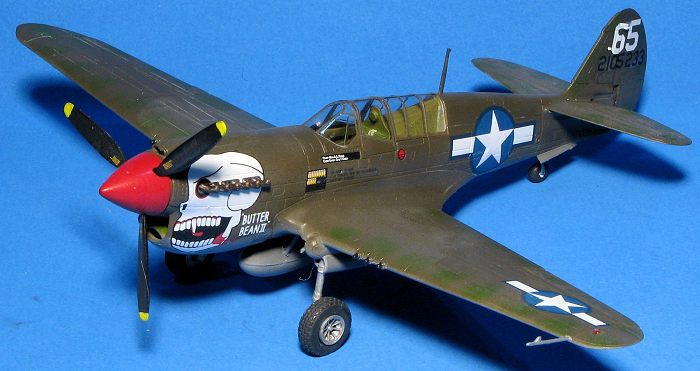 Painting this was pretty basic. I
first did the underside color of Neutral Grey using Mr.Color paint. When dry,
this was masked off and the upper surface painted with Olive Drab, again from
the Mr. Color line. I like this paint as it dries quickly to where you can
handle it within just a few minutes, though it is best to let it cure for longer
than that. As noted on the painting diagram, I painted splotches of medium green
on the edges of all the flight surfaces, but the color sort of disappeared
against the OD background.
Painting this was pretty basic. I
first did the underside color of Neutral Grey using Mr.Color paint. When dry,
this was masked off and the upper surface painted with Olive Drab, again from
the Mr. Color line. I like this paint as it dries quickly to where you can
handle it within just a few minutes, though it is best to let it cure for longer
than that. As noted on the painting diagram, I painted splotches of medium green
on the edges of all the flight surfaces, but the color sort of disappeared
against the OD background.
I then returned to the work bench and removed the masking along with the Silly Putty I used to fill the gear wells. At this time, the landing gear was installed. This is a touch fiddly, but quite solid when done. This was followed by the gear doors. Next the exhaust was installed. Meanwhile I painted the wheels as well as painted the spinner. The latter was red using Tamiya Red paint. The wheels were replacements in resin that have better detail than the kit versions. I used CMK Q72296, which are designed for this kit.
Next a clear was sprayed on the model in preparation for decals. I used kit markings for an 89FS/80FG plane based at Assam, India in 1944. I soon realized I'd made a mistake by gluing on the exhaust before attaching the skull decal, but was able to work around it. When done the airframe was sprayed with a clear matte. The wheels were installed along with the pitot and the radio mast. Masking was removed from the canopy and landing light. A bit of final painting was done and the prop glued into place to finish the kit.
| CONCLUSIONS |
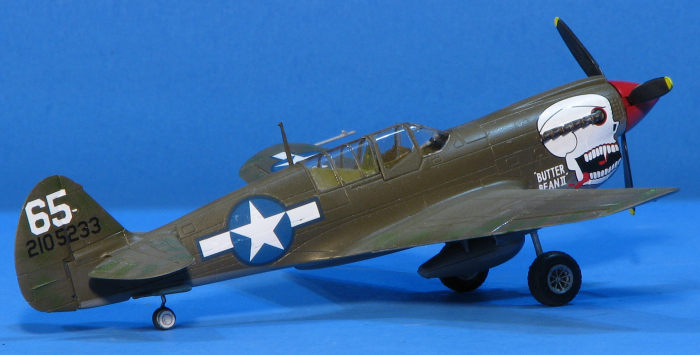 Each time I build one of these
Special Hobby P-40s, I learn a bit more in terms of what mistakes to not make.
One of these days I'll get it all right. Despite a few areas of concern, this is
probably the most accurate and best detailed 1/72 P-40 out there. If you have
other 1/72 P-40 kit, by all means build them, but if you are looking for the
best on the market at the moment, this is it.
Each time I build one of these
Special Hobby P-40s, I learn a bit more in terms of what mistakes to not make.
One of these days I'll get it all right. Despite a few areas of concern, this is
probably the most accurate and best detailed 1/72 P-40 out there. If you have
other 1/72 P-40 kit, by all means build them, but if you are looking for the
best on the market at the moment, this is it.
15 November 2024
Copyright Modeling Madness.com. All rights reserved. No reproduction in part or in whole without express permission from the editor.
If you would like your product reviewed fairly and fairly quickly, please contact the editor or see other details in the Note to Contributors.
Back to the Main Page Back to the Review Index Page Back to the Previews Index Page